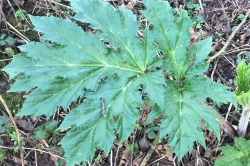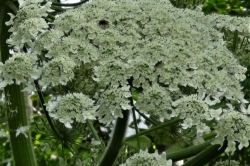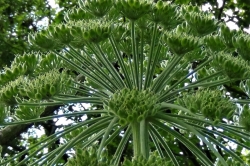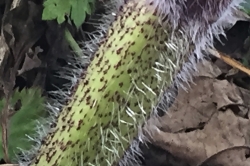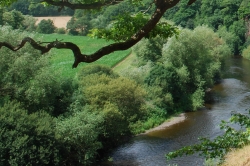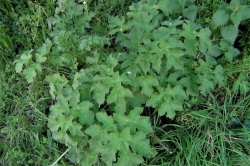Giant Hogweed was brought to the UK by Victorian botanists due to its impressive large flowers and general size, DEFRA would now like to get rid of it.
Home / Hedgerow Guide /
Giant Hogweed
Giant Hogweed
| Hedgerow Type | |
| Common Names | Giant Hogweed, Cartwheel Flower, Hogsbane, Giant Cow Parsley, Giant Cow Parsnip |
| Scientific Name | Heracleum mantegazzianum |
| Season Start | Mar |
| Season End | Oct |
Leaves
Large, shiny and vicious looking with deeply lobed, jagged, sharply serrated leaves. The upper surface of the leaves are hairless unlike common hogweed which has a fine suede like covering of small white hairs. The underside of the leaf is covered in hairs.
Flowers
An umbel (like an umbrella) of small, white, five petaled flowers that can be up to sixty cm in diametre with many ‘spokes’, from fifty to one hundred and fifty on one flower head.
Seeds
It can produce up to 50,000 viable seeds a year which are as large as a penny and as thin as paper.
Stem
Very tall, hollow, can be as thick as a wine bottle, often with purple/black markings or even totally purple/black with thick bristly hairs along the stem particularly around the stem where the leaves emerge.
Habitat
Beside water courses, streams etc. but can be found growing in gardens, allotments, heathland, meadows or waste ground, seemingly nowhere near water but there will be a water source nearby.
Possible Confusion
When small can look like Common Hogweed, pictured, but the leaves of Giant Hogweed are generally lighter, shinier and more vicious looking. Common hogweed leaves, on the upper surface, are covered in tiny hairs giving the leaves a matt finish unlike the hairless, shiny Giant Hogweed leaves. If in doubt wait for the plant to show its true size, up to five metres or wait for the flowers which are size of dinner plates or larger.
Smell
It has been reported that even smelling this plant can have an effect but I can’t say I’m convinced by this.
Taste
Like common Hogweed but far too dangerous to try.
Frequency
Luckily, fairly uncommon but an average plant can produce up to fifty thousand seeds in one year and these seeds can last in the soil or water for some time without damage so if not dealt with can cover a riverbank in thousands of plants in only a couple of years.
Medicinal Uses
This plant is reported as having a few medicinal uses but is too dangerous to risk the benefits you might gain.
Other Facts
An extremely dangerous plant that while not strictly poisonous has phyto-phototoxic properties which mean that if you get the sap on your skin or even brush against the plant, and your skin is exposed to the sun that patch of skin will have no resistance to UV rays. This is due to furanocoumarins which can enter the nucleus of epithereal skin cells and damage the cells DNA leaving it with no protection from UV rays, if this patch of skin is exposed to sunlight it can cause serious burns requiring hospital treatment. This is not the end of your problems, the same patch of skin can react to the sun in the same way for seven to ten years until all of your cells have been replaced. If the sap makes contact with your eyes it can cause temporary or even permanent blindness.
Children can be injured by this plant as its hollow stem has been used as a pretend telescope or sword or the smaller stems used as pea shooters with obvious harmful effects.
Strimming this plant inadvertently can cause the sap to slash onto exposed areas of skin.
You have been warned.

















